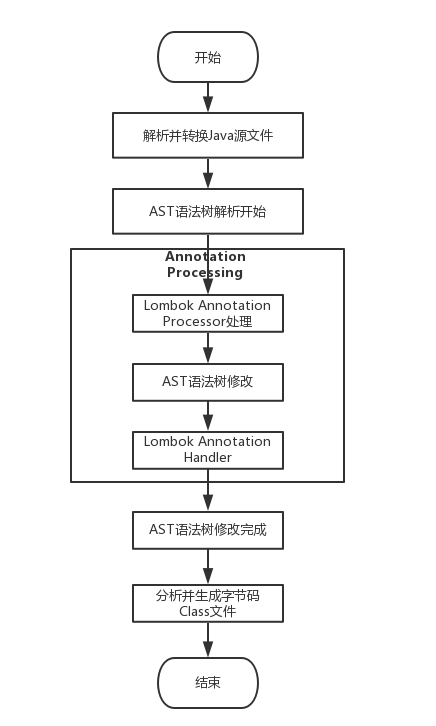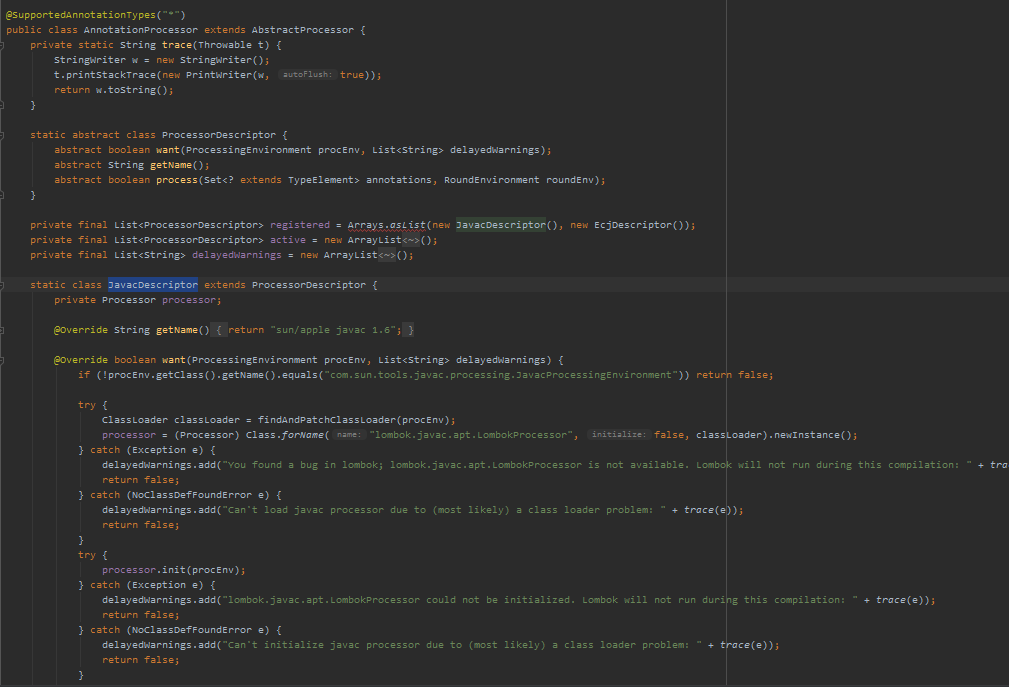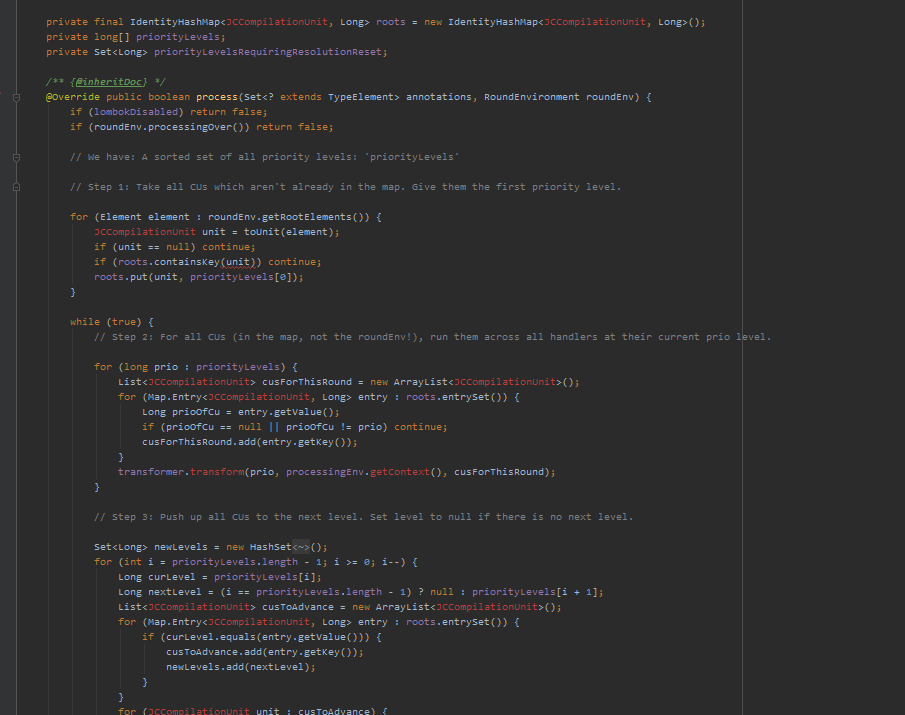优雅编程 之 Lombok
准备工作
- IntelliJ IDEA 中搜索并安装Lombook插件
- maven 引用
<dependency>
<groupId>org.projectlombok</groupId>
<artifactId>lombok</artifactId>
<version>1.16.8</version>
</dependency>
- 开启自动编译配置
Lombook使用介绍
常用注解
- @Getter and @Setter 可以针对类的属性字段自动生成Get/Set方法
public class OrderCreateDemoReq{
@Getter
@Setter
private String customerId;
@Setter
@Getter
private String poolId;
//其他代码……
}
//上面请求Req类的代码相当于如下:
public class OrderCreateDemoReq{
private String customerId;
private String poolId;
public String getCustomerId(){
return customerId;
}
public String getPoolId(){
return poolId;
}
public void setCustomerId(String customerId){
this.customerId = customerId;
}
public void setPoolId(String poolId){
this.pool = pool;
}
}
- @NoArgsConstructor, @RequiredArgsConstructor, @AllArgsConstructor,这几个注解分别为类自动生成了无参构造器、指定参数的构造器和包含所有参数的构造器
@RequiredArgsConstructor(staticName = "of")
@AllArgsConstructor(access = AccessLevel.PROTECTED)
public class ConstructorExample<T> {
private int x, y;
@NonNull private T description;
@NoArgsConstructor
public static class NoArgsExample {
@NonNull private String field;
}
}
//上面代码相当于如下:
public class ConstructorExample<T> {
private int x, y;
@NonNull private T description;
private ConstructorExample(T description) {
if (description == null) throw new NullPointerException("description");
this.description = description;
}
public static <T> ConstructorExample<T> of(T description) {
return new ConstructorExample<T>(description);
}
@java.beans.ConstructorProperties({"x", "y", "description"})
protected ConstructorExample(int x, int y, T description) {
if (description == null) throw new NullPointerException("description");
this.x = x;
this.y = y;
this.description = description;
}
public static class NoArgsExample {
@NonNull private String field;
public NoArgsExample() {
}
}
}
- @NonNull 能够为方法或构造函数的参数提供非空检查
public void notNullExample(@NonNull String string) {
//方法内的代码
}
//=>上面代码相当于如下:
public void notNullExample(String string) {
if (string != null) {
//方法内的代码相当于如下:
} else {
throw new NullPointerException("null");
}
}@ToString 为使用该注解的类生成一个toString方法,默认的toString格式为:ClassName(fieldName= fieleValue ,fieldName1=fieleValue)
用在类的属性字段上,不需要自己手写setter、getter方法。且能指定访问数组
@ToString(callSuper=true,exclude="someExcludedField")
public class Demo extends Bar {
private boolean someBoolean = true;
private String someStringField;
private float someExcludedField;
}
//上面代码相当于如下:
public class Demo extends Bar {
private boolean someBoolean = true;
private String someStringField;
private float someExcludedField;
@ Override
public String toString() {
return "Foo(super=" + super.toString() +
", someBoolean=" + someBoolean +
", someStringField=" + someStringField + ")";
}
}- @EqualsAndHashCode 为使用该注解的类自动生成equals和hashCode方法。
@EqualsAndHashCode(exclude = {"id"}, callSuper =true)
public class LombokDemo extends Demo{
private int id;
private String name;
private String gender;
}
//上面代码相当于如下:
public class LombokDemo extends Demo{
private int id;
private String name;
private String gender;
@Override
public boolean equals(final Object o) {
if (o == this) return true;
if (o == null) return false;
if (o.getClass() != this.getClass()) return false;
if (!super.equals(o)) return false;
final LombokDemo other = (LombokDemo)o;
if (this.name == null ? other.name != null : !this.name.equals(other.name)) return false;
if (this.gender == null ? other.gender != null : !this.gender.equals(other.gender)) return false;
return true;
}
@Override
public int hashCode() {
final int PRIME = 31;
int result = 1;
result = result * PRIME + super.hashCode();
result = result * PRIME + (this.name == null ? 0 : this.name.hashCode());
result = result * PRIME + (this.gender == null ? 0 : this.gender.hashCode());
return result;
}
}@Data = @ToString + @EqualsAndHashCode + @Getter + [非final字段]@Setter +@RequiredArgsConstructor
其包含注解的集合@ToString,@EqualsAndHashCode,所有字段的@Getter和所有非final字段的@Setter,@RequiredArgsConstructor。其中@RequiredArgsConstructor使用了类中的带有@NonNull注解的或者final修饰的成员变量,它可以使用@Data(staticConstructor=”methodName”)来生成一个静态方法,返回一个调用相应的构造方法产生的对象
注意:
- @NoArgsConstructor会覆盖@Data中的@RequiredArgsConstructor的相关方法,两者是互相冲突的
- @Data(staticConstructor=”yoz”) 等效于 @RequiredArgsConstructor(staticName = “yoz”)
@Data(staticConstructor="yoz")
public class DataExample {
private String x;
@NonNull
private int y;
@NonNull
private boolean z;
}
//等效于 留意yoz方法
public class DataExample {
private String x;
@NonNull
private int y;
@NonNull
private boolean z;
@java.beans.ConstructorProperties({"y", "z"})
private DataExample(int y, boolean z) {
this.y = y;
this.z = z;
}
public static DataExample yoz(int y, boolean z) {
return new DataExample(y, z);
}
public String getX() {
return this.x;
}
@NonNull
public int getY() {
return this.y;
}
@NonNull
public boolean isZ() {
return this.z;
}
public void setX(String x) {
this.x = x;
}
public void setY(int y) {
this.y = y;
}
public void setZ(boolean z) {
this.z = z;
}
public boolean equals(Object o) {
if (o == this) return true;
if (!(o instanceof DataExample)) return false;
final DataExample other = (DataExample) o;
if (!other.canEqual((Object) this)) return false;
final Object this$x = this.x;
final Object other$x = other.x;
if (this$x == null ? other$x != null : !this$x.equals(other$x)) return false;
if (this.y != other.y) return false;
if (this.z != other.z) return false;
return true;
}
public int hashCode() {
final int PRIME = 59;
int result = 1;
final Object $x = this.x;
result = result * PRIME + ($x == null ? 0 : $x.hashCode());
result = result * PRIME + this.y;
result = ((result * PRIME) + (this.z ? 79 : 97));
return result;
}
public boolean canEqual(Object other) {
return other instanceof DataExample;
}
public String toString() {
return "com.example.chapter1.lombok.DataExample(x=" + this.x + ", y=" + this.y + ", z=" + this.z + ")";
}
}- @Builder注解提供了一种比较推崇的构建值对象的方式
@Builder
public class BuilderExample {
private String name;
private int age;
@Singular private Set<String> occupations;
}
//上面代码相当于如下:
public class BuilderExample {
private String name;
private int age;
private Set<String> occupations;
BuilderExample(String name, int age, Set<String> occupations) {
this.name = name;
this.age = age;
this.occupations = occupations;
}
public static BuilderExampleBuilder builder() {
return new BuilderExampleBuilder();
}
public static class BuilderExampleBuilder {
private String name;
private int age;
private java.util.ArrayList<String> occupations;
BuilderExampleBuilder() {
}
public BuilderExampleBuilder name(String name) {
this.name = name;
return this;
}
public BuilderExampleBuilder age(int age) {
this.age = age;
return this;
}
public BuilderExampleBuilder occupation(String occupation) {
if (this.occupations == null) {
this.occupations = new java.util.ArrayList<String>();
}
this.occupations.add(occupation);
return this;
}
public BuilderExampleBuilder occupations(Collection<? extends String> occupations) {
if (this.occupations == null) {
this.occupations = new java.util.ArrayList<String>();
}
this.occupations.addAll(occupations);
return this;
}
public BuilderExampleBuilder clearOccupations() {
if (this.occupations != null) {
this.occupations.clear();
}
return this;
}
public BuilderExample build() {
Set<String> occupations = new HashSet<>();
return new BuilderExample(name, age, occupations);
}
@verride
public String toString() {
return "BuilderExample.BuilderExampleBuilder(name = " + this.name + ", age = " + this.age + ", occupations = " + this.occupations + ")";
}
}
}- @Cleanup 能够自动释放资源
public void jedisExample(String[] args) {
try {
@Cleanup Jedis jedis = redisService.getJedis();
} catch (Exception ex) {
logger.error(“Jedis异常:”,ex)
}
//=>上面代码相当于如下:
Jedis jedis= null;
try {
jedis = redisService.getJedis();
} catch (Exception e) {
logger.error(“Jedis异常:”,ex)
} finally {
if (jedis != null) {
try {
jedis.close();
} catch (Exception e) {
e.printStackTrace();
}
}
}
}
@Synchronized
类似Java中的Synchronized 关键字,但是可以隐藏同步锁
注解用在类方法或者实例方法上,效果和synchronized关键字相同,区别在于锁对象不同,对于类方法和实例方法,synchronized关键字的锁对象分别是类的class对象和this对象,而@Synchronized得锁对象分别是私有静态final对象LOCK和私有final对象lock,当然,也可以自己指定锁对象
public class SynchronizedExample {
private final Object readLock = new Object();
@Synchronized
public static void hello() {
System.out.println("world");
}
@Synchronized("readLock")
public void foo() {
System.out.println("bar");
}
//上面代码相当于如下:
public class SynchronizedExample {
private static final Object $LOCK = new Object[0];
private final Object readLock = new Object();
public static void hello() {
synchronized($LOCK) {
System.out.println("world");
}
}
public void foo() {
synchronized(readLock) {
System.out.println("bar");
}
}
}@SneakyThrows
注解用在方法上,可以将方法中的代码用try-catch语句包裹起来,捕获异常并在catch中用Lombok.sneakyThrow(e)把异常抛出,可以使用@SneakyThrows(Exception.class)的形式指定抛出哪种异常,很简单的注解
@SneakyThrows
public void testSneakyThrows() {
throw new IllegalAccessException();
}
public void testSneakyThrows() {
try {
throw new IllegalAccessException();
} catch (java.lang.Throwable $ex) {
throw lombok.Lombok.sneakyThrow($ex);
}
}- @val 声明变量类型为final
public static void main(String[] args) {
val setVar = new HashSet<String>();
val listsVar = new ArrayList<String>();
val mapVar = new HashMap<String, String>();
//=>上面代码相当于如下:
final Set<String> setVar2 = new HashSet<>();
final List<String> listsVar2 = new ArrayList<>();
final Map<String, String> maps2 = new HashMap<>();
}
@Log
这个注解用在类上,可以省去从日志工厂生成日志对象这一步,直接进行日志记录,具体注解根据日志工具的不同而不同,同时,可以在注解中使用topic来指定生成log对象时的类名。不同的日志注解总结如下(上面是注解,下面是实际作用)
@CommonsLog
private static final org.apache.commons.logging.Log log = org.apache.commons.logging.LogFactory.getLog(LogExample.class);
@JBossLog
private static final org.jboss.logging.Logger log = org.jboss.logging.Logger.getLogger(LogExample.class);
@Log
private static final java.util.logging.Logger log = java.util.logging.Logger.getLogger(LogExample.class.getName());
@Log4j
private static final org.apache.log4j.Logger log = org.apache.log4j.Logger.getLogger(LogExample.class);
@Log4j2
private static final org.apache.logging.log4j.Logger log = org.apache.logging.log4j.LogManager.getLogger(LogExample.class);
@Slf4j
private static final org.slf4j.Logger log = org.slf4j.LoggerFactory.getLogger(LogExample.class);
@XSlf4j
private static final org.slf4j.ext.XLogger log = org.slf4j.ext.XLoggerFactory.getXLogger(LogExample.class);Constructor专题
@RequiredArgsConstructor
会生成一个包含常量,和`标识了NotNull的变量` 的构造方法。生成的构造方法是private,如果想要对外提供使用可以使用staticName选项
生成一个static方法
@RequiredArgsConstructor(staticName = "sunsfan")
@AllArgsConstructor(access = AccessLevel.PROTECTED)
@NoArgsConstructor
public class Shape {
private int x;
@NonNull
private double y;
@NonNull
private String name;
}
//等效于
public class Shape {
private int x;
private double y;
private String name;
public Shape(){
}
protected Shape(int x,double y,String name){
this.x = x;
this.y = y;
this.name = name;
}
public Shape(double y,String name){
this.y = y;
this.name = name;
}
public static Shape sunsfan(double y,String name){
return new Shape(y,name);
}
}
@AllArgsContructor
会生成一个包含所有变量,同时如果变量使用了NotNull annotation , 会进行是否为空的校验
@NoArgsConstructor
生成一个无参数的构造方法,这个annotation在与其他的annotation配合起来使用的时候更加能凸显出他的重要性,例如在使用hibernate这
种框架的时候,如果有一个有参数的构造方法的时候,NoArgsConstructor会展示出他的作用
自定义注解原理
Lombok不是通过字节码改写来实现的。它主要是用编译器内支持的annotation processing,直接操纵抽象语法树(AST),根据需要添加新节点。依靠可插件化的Java自定义注解处理API(JSR 269: Pluggable Annotation Processing API)来实现在Javac编译阶段利用“Annotation Processor”对自定义的注解进行预处理后生成真正在JVM上面执行的“Class文件”。其大致执行原理图如下:

从上面的这个原理图上可以看出Annotation Processing是编译器在解析Java源代码和生成Class文件之间的一个步骤。其中Lombok插件具体的执行流程如下:

从上面的Lombok执行的流程图中可以看出,在Javac 解析成AST抽象语法树之后, Lombok 根据自己编写的注解处理器,动态地修改 AST,增加新的节点(即Lombok自定义注解所需要生成的代码),最终通过分析生成JVM可执行的字节码Class文件。使用Annotation Processing自定义注解是在编译阶段进行修改,而JDK的反射技术是在运行时动态修改,两者相比,反射虽然更加灵活一些但是带来的性能损耗更加大。

从熟悉JSR 269: Pluggable Annotation Processing API的同学可以从工程类结构图中发现AnnotationProcessor这个类是Lombok自定义注解处理的入口。该类有两个比较重要的方法:一个是init方法,另外一个是process方法。在init方法中,先用来做参数的初始化,将AnnotationProcessor类中定义的内部类(JavacDescriptor、EcjDescriptor)先注册到ProcessorDescriptor类型定义的列表中。其中,内部静态类—JavacDescriptor在其加载的时候就将lombok.javac.apt.LombokProcessor这个类进行对象实例化并注册。
在LombokProcessor处理器中,其中的process方法会根据优先级来分别运行相应的handler处理类。Lombok中的多个自定义注解都分别有对应的handler处理类,如下图所示:

可以看出,在Lombok中对于其自定义注解进行实际的替换、修改和处理的正是这些handler类。对于其实现的细节可以具体参考其中的代码。
如果想自己动手写个Getter方法,可以参考下文
REFRENCES
微信公众号

扫码关注或搜索架构探险之道获取最新文章,坚持每周一更,坚持技术分享的我和你们一起成长 ^_^ !